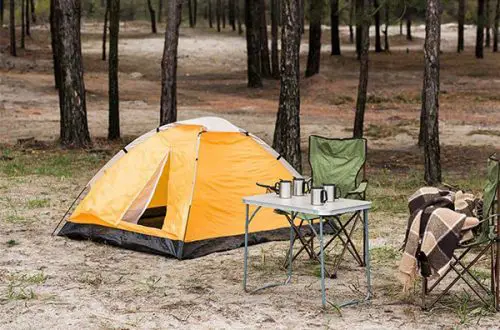The Definitive Buyers Guide: How to Choose Walking Poles and Trekking Poles
Table of Contents
Most people assume that when you go hiking, all you need are your two feet. Now, though they’re not wrong, sometimes however, you need a little more support than that. Your two feet will get you up and down on almost any terrain, however, if you’re looking for more stability, your feet will need some help.
Traditionally, walking sticks have been used for decades as a reliable and inexpensive way of providing you more stability.
Looking for other accessories? Check out these other popular camping gear:
Walking poles can give you the extra stability needed, plus, provide you with a couple of extra workout benefits. There are a couple of different types of poles including trekking and fitness walking poles, each coming with their unique benefits.
Not sure which one you need? Don’t worry, you’re going to learn everything there is to know about walking and trekking poles, thus, by the end of this article, you’ll know exactly what you need.
Why do you even need walking or trekking poles?
If you were hiking with trekking or walking poles ten years ago, you’d have been in the minority, however now, they’re highly popular among outdoor enthusiasts.
But why is that? Is this just a trend or is there a specific reason why everyone’s jumping on board with trekking and walking poles? Well, actually, they’re an essential tool and there are a couple of valid reasons why everybody is including them in their hiking or mountaineering gear.
- Poles, whether, walking or trekking, are designed in a similar fashion to ski poles. They allow you to use your arms in order to propel you forward. This can be done whether you’re on a flat surface or a mountain, as it’ll help you push yourself and increase your speed.
- They reduce the impact on your joints, specifically in your legs, knees, ankles, and of course, feet. When you’re going downhill, there’s more pressure on these areas and poles help you reduce the force placed on them. Thus, if you have issues with your knees and legs, poles allow you to relieve some of the pressure.
- Trekking and walking poles can be used to help you walk through surrounding vegetation. In some areas, where you’ll be walking there won’t necessarily be a distinct and clear path. Instead, there may be prickly or thick vegetation that you’ll need to get through. Poles help you push the vegetation away, thus, they’re a great tool for backcountry travel.
- When you’re walking, you want to develop a sturdy and steady rhythm. Poles can not only increase your speed but also help you develop a consistent rhythm.
- If you’re hiking or mountaineering in areas which are muddy, slippery or icy, poles will support you and help you maintain your balance. This is why they’re an essential tool for those who are travelling off-season or in the backcountry.
- If you’re going to be hiking or mountaineering in the backcountry, you may encounter areas which will require you to walk across rivers and streams. These are vulnerable situations where having proper balance is a must unless you want to fall in. Poles will help you maintain stability while crossing rivers.
- Poles can alleviate weight that you’re carrying. If you need a break, take off your backpack and lean on your pole. It’ll help give you a quick time-out.
- Poles are multi-purpose. Yes, they’re designed to help you maintain balance while you’re walking, however, they can be used for other purposes as well. You can use them to pitch a tent as they’re highly durable and wind-resistant. If there’s an accident, you can use your pole as a makeshift splint. In addition, you can also use it as a paddle.
What to consider when looking for a trekking pole
There are a couple of things you need to ask yourself when looking for the right walking/trekking pole. By asking yourself these questions, you’ll be able to narrow down your search.
- What’s your budget?
- What type of walking and terrain will the poles be used for?
- Would you like non-shock or anti-shock poles?
- How light would you like them to be?
- How small do you want to be able to pack them down to?
What’s your budget?
Like with anything, there is expensive equipment and inexpensive equipment. Keep in mind that even if you’re on a budget, you’ll be able to find good-quality trekking and walking poles. Many expensive trekking poles on the market are essentially the same as budget-friendly ones, however, they come with a couple of gadgets that are convenient but not necessary.
What type of walking and terrain will the poles be used for?
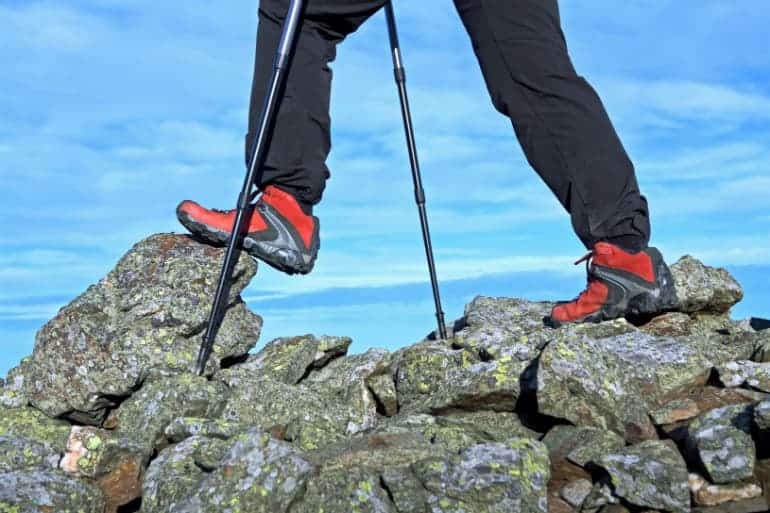
Before you go and choose a pole, you need the pole to suit the environment you’re going to be walking in. Are you going to be in the rugged mountains? Hiking up and down hills? Are you carrying a backpack? These are questions you need to have answers to. If you’re going to be walking and hiking on a variety of terrain, you should opt for a pole which will support multi-terrain use.
Would you like non anti-shock or anti-shock poles?
There are two different types of shock resistance: anti-shock and non anti-shock.
Anti-shock: This helps to reduce impact by 40% which helps to ensure that your muscles, joints, and ligaments are properly protected during your hike. Thus, it’s best for those which are already experiencing some joint issues already, yet want to prevent it from getting worse.
Though, if you’re really into mountaineering, getting anti-shock poles will help prevent any future joint, muscle, and ligament issues. It’s important to note that these poles can add a little more weight to them as they’re built with an extra mechanism.
Non-shock: the only difference is that non anti-shock poles do not have the anti-shock mechanism in place. Thus, when walking on terrain, you’re not provided with the extra absorption that the anti-shock poles provide users.
How light would you like them to be?
When it comes to poles, you’d like your pole to be as light as possible, especially if you’re carrying a backpack. When you’re walking, you’re going to be lifting your pole with each step, thus, if it’s heavy, you’re going to feel it.
When it comes to weight, the poles are affected by the shaft material, diameter, and handle. Lighter poles will typically have shorter shafts, are thinner in diameter and are made with lightweight materials such as aluminium.
How small do you want to be able to pack them down to?
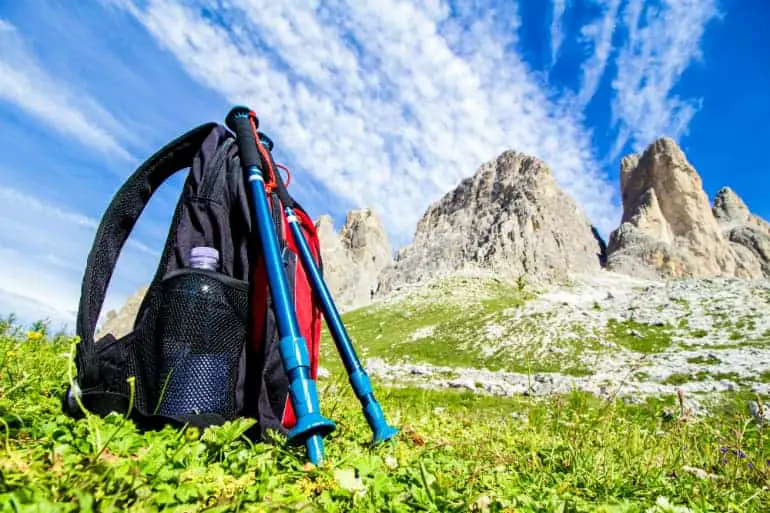
The amount of sections a pole has will ultimately affect the strength of the shaft and their packed size. You have a couple of options when it comes to the design of the poles as they come in two and three- section poles, folding and combination style. If you want to fit them in a bag or attach them to a sling like the patagonia atom sling, they’ll need to compact down.
Two Section
Two section poles are known as the strongest and sturdiest poles in design. If you’re going to be skiing, snowshoeing or tend to be hard on your poles, then you should opt for this design. Though, two section poles tend to pack down the least in comparison to the other options.
However, this is the reason as to why they’re so sturdy. Much of the poles tend to overlap which gives the pole its extra strength. They’re not lightweight and are usually a lot heavier than the other designs, however, they’re the strongest.
Three Section
The three section telescoping pole is the most commonly used pole on the market. Most of the poles you’ll find in sporting stores will have a three section design. They’re a great middle option as they’re easy to strap onto backpacks and can fit into an average sized suitcase with ease.
The three section design weighs typically the same as a two section but isn’t as durable. Naturally, they can handle rough use, however, are best for users who are planning to hike, trek, climb, mountaineer, and backpack.
Folding Pole Style
This is a relatively newer design for poles and hasn’t been out on the market for too long. The folding poles are the lightest and most compact poles on the market. However, they’re simply not as durable as the two-section or three-section poles.
As a climber or hikers, you’ll be able to use these poles on trails and cross-country travel, however, you won’t be able to use them for intense climbing and mountaineering. If you’re a climber or backpacker, you’ll particularly like them because they’re easy to transport and pack up.
Most folding style poles are at least 7 inches shorter than a two or three-section pole and can be as much as 14 ounces lighter as well. This is a substantial amount of weight taken off, especially if you’re going to be backpacking.
Combination
There are many new poles on the market which are designed with a one section telescoping feature that allows you to adjust the pole when it’s deployed. This is generally a great addition to the folding style pole as it allows for more versatility.
It’s still not as flexible as the three-section pole, however, depending on what you’re using it for, it takes the best parts of each style and puts it together.
Types of poles
Now, you may be wondering if all hiking and mountaineering poles are the same, but the truth is that they’re not. There are a couple different types of poles which serve different purposes.
We’re going to show you the types of poles available so that you can see which one suits you the best. Though you may think that you can just use any pole, trekking poles and Nordic walking poles are different.
Hiking Poles and Trekking Poles
Like in their name, trekking and hiking poles are specifically designed for hiking on a variety of terrain whether it’s mountains, hills or rugged backcountry. Their goal is to make it easy for you to hike, increase your power and endurance, support your joints and provide you with extra balance. Typically, their features include:
- Designed with either two or three sections
- Interchangeable baskets to prevent poles from sinking into the terrain
- Adjustable poles for improved performance
- Adjustable straps to reduce hand strain
- Concave flextips for high performance on rugged terrain
When using trekking poles, there’s a specific technique when going up and downhill:
- Uphill: When going uphill, you use the poles to push behind you, propelling your body forward. This also promotes the use of your larger muscles in the back of your legs as well as your core muscles. By using these muscles, you increase your speed up the hill.
- Downhill: When going downhill, the poles are used in the front of your body to support your joints and remove the pressure and force from them.
Nordic Walking Poles
Nordic walking poles are designed for exercise, fitness and well-being. They’re generally designed to be used on flat surfaces or small hills. Typically, their features include:
- A releasable strap system
- Removable rubber angled tips which assist with pushing forward
- Lightweight poles in either two or three sections
- Non-adjustable poles as the terrain doesn’t change
When using Nordic walking poles, there’s a specific technique when using them:
- The poles are used next to the body and behind the body to push yourself forward
- The body’s natural reciprocal gait is accentuated when using Nordic walking poles
- The key to Nordic walking poles consists in the length and spinal rotation when using them. This promotes more muscle use and prevents extra exertion.
Features to consider when looking for trekking poles
When you’re looking for the best trekking poles, that can be quite objective. However, there are some features which are universally desired when looking for the right Trekking Poles.
Versatility
When it comes to versatility, this doesn’t mean whether or not you can bend your pole into different shapes. Versatility refers to how many things you pole can do. For example, whether your pole is able to handle a variety of terrains or not. You’ll want your pole to support you on whatever activity you’re doing, whether it’s hiking, backpacking, mountaineering, or climbing.
Overall, you’ll have to acknowledge that skiing and snowshoeing poles are different than hiking poles, thus, cannot be interchanged in that particular instance. Though a general rule to follow is that poles that are able to compact down to a small size are best used for activities where you can carry them via backpack, this includes climbing and mountaineering.
Whereas poles that are shock absorbent are best used for hard terrain as they’re able to endure pressure, however, they’re not great for rugged terrain when you’re needing your poles for balance.
Though, for adjustable poles that offer exchangeable baskets, you’ll be able to use them for a wider range of activities than the others. It just depends on the type of activity you’re wishing to do and the frequency of it.
Packability
Again, this depends on what you’re using your poles for. See how important it is to answer that question? That one question alone will significantly narrow down your search for the best trekking poles.
For some people, packability isn’t that important to them as they’re looking for a sturdy and solid pole. However, in some other cases, such as climbers, backpackers, and mountaineers, those that are carrying gear with them, they’re looking for poles which are compatible and easy to transport.
If you’re someone who’s looking for a packable trekking or hiking pole, then you’ll be opting for poles which are generally shorter in length. Though, there are some disadvantages to them as they’re not as durable as two-section poles.
However, when it comes to packability, they’re amazing. They’re very easy to travel with, you can fit them into your suitcase or attached them to your backpack. But then again, if you’re not interested in the size of your poles due to travel or packing reasons, then there’s not really a need to opt for compact poles.
Basket Size
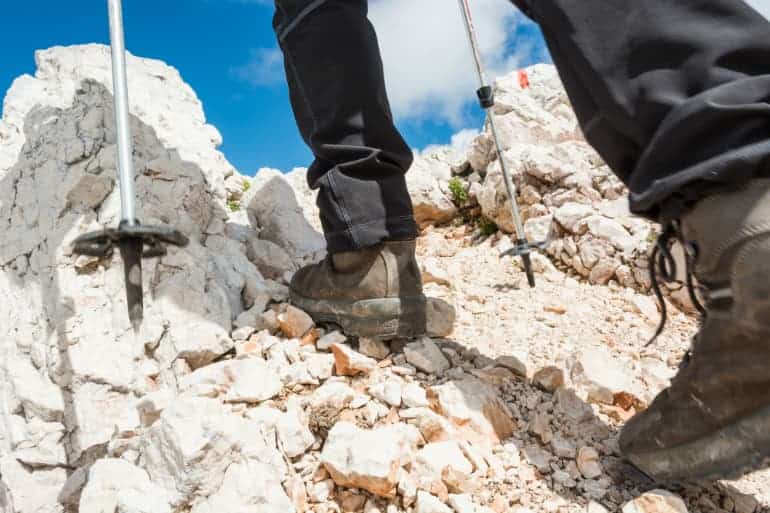
When it comes to basket size, it truly depends on what type of activity you’re planning on doing. There are some poles which come with fixed baskets while other poles provide you with the option of an interchangeable basket. Many pole manufacturers will have different diameter holes for their baskets which makes it hard to use different brand baskets of different brand poles.
But, this doesn’t mean all hope is lost. There are some companies which produce crossovers that allow you to use their baskets on different brand poles and vice versa. When you’re buying baskets for your poles, take your poles with you to the shop to make sure that they’re properly fitted. If not, you’ll have to find yourself different baskets.
Remember that larger baskets are ideal for snow, however, can easily get caught in roots and vegetation if you’re planning on using them to hike. You can sometimes find ¾ baskets, however, in the end, removable baskets provide you with the most versatility for all types of terrain in comparison to the others.
Pole adjustment mechanisms
There are a couple different pole adjustment mechanisms that are used with trekking poles. A lever lock mechanism is easy to use, durable, and quick in comparison to other mechanisms such as the twist lock. In addition, it’s more long lasting which shows as more and more companies are switching over to the lever lock adjustment mechanism.
In general, the twist lock mechanism is less secure and when confronted with dirt and debris it can cause the mechanism to jam and that’s really not what you want to happen during your hike. Overall, though you can choose a twist lock mechanism, why deal with the hassle as the lever lock has proven to be more efficient and durable.
Material
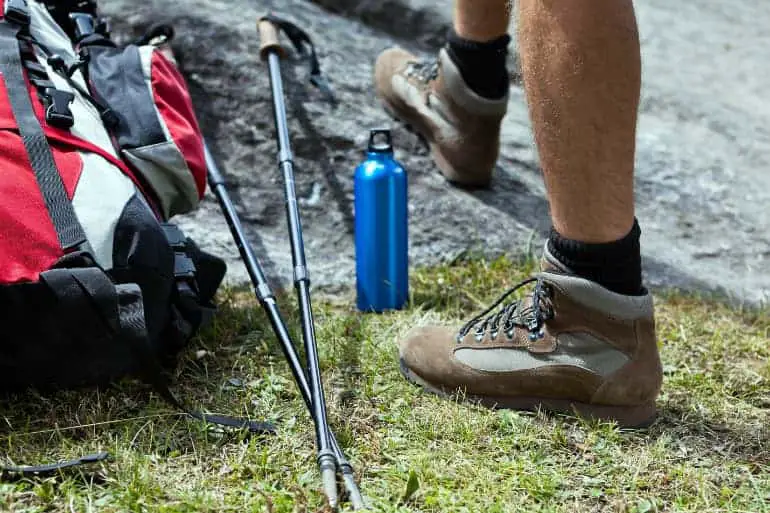
Material plays a huge factor in the durability and weight of a trekking pole. Aluminium and carbon fiber are the two most common materials used for trekking poles.
Carbon is considered lightweight, however, is more fragile when it comes to being involved in any impact. The poles may dent or crack, and possibly, even snap. Whereas, aluminium is a slightly heavier material, however, is able to be thrown around without worry of damaging it. In addition, if they do receive damage, it’s easy to repair. If you’re also on a budget, aluminum tends to be cheaper than carbon.
Carbon
- Lightweight
- Stiffer
- Does not do well against impact
- Can dent, crack or snap much easier than aluminium
Aluminum
- Heavier than carbon
- More durable against impact
- Cheaper to repair
- Overall cheaper to purchase than carbon poles – budget-friendly
Shock Absorbers
We talked about shock absorbing poles earlier on, however, it’s important to emphasize this. You can opt for shock absorbers on your poles which will help ease the pressure from your joints. Many people do not use shock absorbers, whereas some hikers swear by them.
Shock absorbers can be a nice feature as they give you more power and take the pressure off of your joints. However, they’re not ideal for when you need extra balance such as when you’re jumping from rock to rock.
Weight
When it comes to weight, everyone wants a lighter option. Though at the same time, many of us assume that because an item is lighter, it must be fragile in comparison to a non-lightweight item. And this may be true for some products, however, when it comes to trekking poles, there’s not a huge difference between lightweight and non-lightweight poles.
An average pair of poles weigh between 16 and 18 ounces whereas lightweight pole weighs around 14 ounces. Though at first glance an additional few ounces may not seem like a lot, it can be quite a burden on your arms after a couple hours of walking.
On an average multi-day hike, you’ll be moving your arms up to 10,000 times or more. Right now, it may not seem like a lot, but once you’re on your hike, you’ll get to feel it. Thus, after hours of walking, the fatigue can really hit you, thus, it’s best to try for a lightweight option, specifically if you haven’t done this before.
Grip
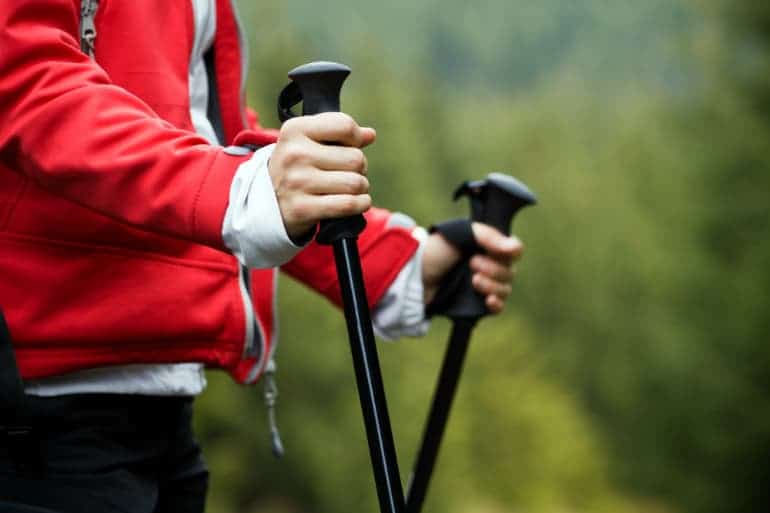
Now, each pole has its own handle design, however, regardless of design they’re either made of foam, rubber, or cork. Each material has it own advantages and disadvantages.
- Foam: If a handle has a foam grip, it will feel the least cold, however, for those walking, this usually isn’t something that people notice. Foam is highly comfortable.
- Rubber: In the case of rubber grips, they don’t absorb any water which makes it ideal for those who are snowshoeing, skiing, mountaineering or performing other winter activities. Though rubber grips are the heaviest ones on the market.
- Cork: A cork grip is a favorite among users as it molds to the shape of your hand. They’re also cooler than rubber grips, however, can still make your hands a bit sweaty.
How to make your poles last longer
Like anything we buy, we want to get the most out of it. There are a couple of things you can do to make sure you increase the lifespan of your trekking and hiking poles. These tricks will help keep your poles in full functioning form.
- If your poles expand, which most do, you’ll need to make sure the areas in which they adjust are kept clean. It’s easy for the interior of the poles to get dirty or wet which can cause some problems. Here’s what you need to do:
- On a regular basis make sure you disassemble the poles, specifically after trips which were rainy. Of course, with the poles you’ll have received an instruction manual which will guide you through the disassembly process. Make sure the components are dry.
- Clean the interior of the poles with a gun-barrel brush or a rag cloth attached to a clothing hanger. This will help you remove any dampness and debris.
- Remove the retainer clip and plug and clean the screw threads.
- If you find the pole is slipping, then replace the expanders which are inexpensive to purchase.
- Check the shafts on a regular basis for any cracks. If there are cracks, contact the manufacturer.
- Do not use any lubricant on the poles.
Are there any drawbacks?
Listen, nothing is perfect. Everything we use, whether it’s a smartphone, hiking shoes, or trekking poles has some disadvantages. In general, walking or trekking poles are quite easy to use and bring along as an essential tool. However, there can be some disadvantages.
Firstly, trekking or walking poles can get caught up and tangled in bushes and stuck in rocks. This is simply something you need to pay attention to when you’re hiking.
Secondly, poles cannot be stored conveniently. You’re not able to fold them up and put them in your backpack. Poles come as one solid unit, as that’s what gives them their strength and durability. So, once you have the poles with you, you can either attach them to your backpack or carry them as those are your only options.
Extra tips
- When travelling with your poles, specifically via plane, you need to make sure that your poles are allowed in carry-on. Though you can put them in your main luggage, carry-on luggage has some rules which you must abide by. Of course, this depends greatly on the company you’re flying with. If you’re not sure, have them in your main luggage, that way, you won’t experience any problems.
- Learn how to walk with your poles as it’s a little different than walking hands-free. You want to be able to use your poles to your full advantage, thus, knowing the proper techniques will help you greatly. In addition, if you’re not using them properly, you may be causing premature fatigue to occur.
- One or two poles? This truly depends on you. However, you’ll have more stability and balance with two poles. In addition, your weight will be evenly distributed whereas one pole leaves you dependant on one side of your body.
- Expensive isn’t always better. We easily get caught up with assuming the more expensive an item is, the better it is. However, that’s not necessarily true. There are many budget-friendly options available in trekking poles that are high-quality. You simply need to find out which one suits you.
- Don’t forget to take some time after your hike and clean your poles. You want to remove any moisture and debris from your poles in order to ensure proper use for your next hike. Take care of them and they’ll take care of you.
Conclusion
Whether you’re hiking, trekking, mountaineering, or backpacking, you want to make sure you’re properly equipped. With that being said, before you venture off into the wilderness, you need to make sure you have your essential tools with you.
One of the tools on your list should be a trekking or hiking pole. These poles will be able to act as a support during your walk and will give you the balance you need. In addition, you’ll be able to engage more of your body in your hike rather than just your legs.
When you’re hiking in difficult terrain, you’ll need the extra support and balance. A pair of trekking poles will keep your feet planted on the ground and you won’t have to worry about slipping or falling as the poles help to keep you more alert of what’s in front of you.
With this guide, you’ll be able to find the best walking poles for your trip. Now that you know trekking poles are an essential tool for your hiking trip, it’s about time you bought yourself a pair. Whatever your budget is or terrain you’ll be climbing, there’s a pair of trekking poles out there for you.
With that being said, make sure that you look at the type of terrain you’ll be walking on, the weight of the poles, and if you’re interested in anti-shock or non anti-shock poles. These questions may seem small, but after you answer them, you’ll have a better idea of what type of pole you’re really looking for.
When it comes to trekking poles, though they all may look the same, each of them are very different. Don’t rush the process in finding one, make sure you take your time and choose a pole that suits your needs and not the other way around. Happy trekking!




